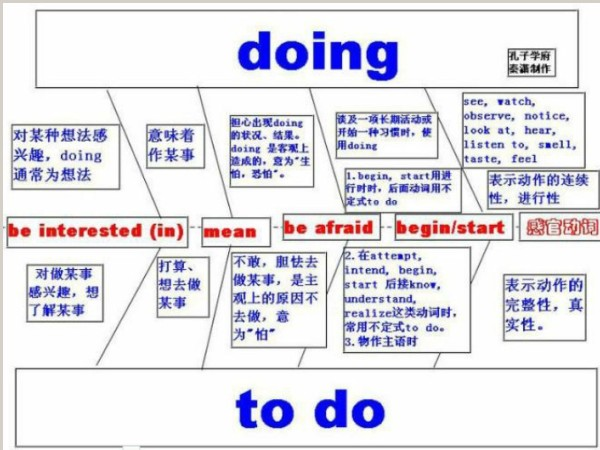本试题 “The lady insisted that the young man ____ her wallet and insisted on ____ to the police station at once.A. had stolen; be sentB. should steal; send...” 主要考查您对动名词
过去完成时
等考点的理解。关于这些考点您可以点击下面的选项卡查看详细档案。
- 动名词
- 过去完成时
动名词概念:
动名词是一种兼有动词和名词特征的非限定动词。它可以支配宾语,也能被副词修饰,动名词有时态和语态的变化。
现在分词和动名词用法比较:
动词的-ing形式包括现在分词和动名词两种形式。他们的句法功能如下:
动词的-ing形式如果作句子的主语或者宾语时,应该是动名词形式;如果作补语或者状语时,应该是现在分词形式。那么作表语或者定语的动名词和现在分词又该怎样区分呢?
1、动名词与现在分词作表语时的比较:
(1)动名词作表语说明主语的内容,回答what的问题;现在分词作表语相当于形容词作表语,说明主语的性质、特征等,回答how的问题。
如:One of the best exercises is swimming. 游泳是最好的运动项目之一。
What pleases him most is bathing in the sea. 最使他高兴的事是在海中沐浴。
The situation both at home and abroad is very in-spiring. 国内外的形势都很鼓舞人心。
The color is pleasing to the eye. 颜色悦目。
(2)动名词作表语,表语和主语几乎处于同等地位,可以互换位置,其句意不变;现在分词作表语,表语和主语则不能互换位置。
如:Our work is serving the people.
(=Serving the people is our work.)我们的工作是为人民服务。
The news was disappointing. 那消息令人失望。
(3)作表语的现在分词前可以用very,quite,rather,greatly等副词修饰,而动名词则不可以。
如:What he said was very encouraging. 他的话很鼓舞人心。
Our goal is realizing the four modernizations in the near future. 我们的目标是在不久的将来实现四个现代化。
(4)现在分词与形容词一样可以和more,the most构成形容词的比较级和最高级,而动名词则不可以。
如:The story is the most fascinating. 那个故事最迷人。
(5)作表语用的现在分词除了和be连用以外,还可以和其它的系动词连用;而作表语的动名词则通常只能和be连用。
如:His speech seems inspiring.他的演讲似乎很鼓舞人心。
His interest is writing for the news papers. 他的爱好是给报社写文章。
(6)有些用作表语的现在分词已经形容词化了。常见的有:exciting,moving,inspiring,missing,interesting,disappointing等。
2、动名词与现在分词作定语时的比较:
(1)动名词作定语时,表示它所修饰的名词的性能和用途,和它所修饰的名词在逻辑上没有主谓关系;
现在分词作定语时,表示它所修饰的名词正在进行的动作,和它所修饰的名词在逻辑上有主谓关系,常可以扩展成一个定语从句。
如:a swimming girl=a girl who is swimming 一个在游泳的姑娘
a walking stick=a stick that is used for walking 一根拐杖
(2)现在分词作定语有时可以后置,而动名词则通常只能放在它所修饰的名词之前。
如:The girl wearing glasses is one of his students. 戴眼镜的那个女孩是他的一个学生。
I bought some reading materials. 我买了一些阅读材料。
动名词的用法:
1、作主语:
例如:Fighting broke out between the South and the North. 南方与北方开战了。
2、作宾语:
a. 有些动词可以用动名词作宾语。
例如:admit承认 appreciate感激 avoid避免 complete完成 consider认为 delay耽误 deny否认 detest讨厌 endure忍受 enjoy喜欢 escape逃脱 fancy想象 finish完成 imagine想象 mind介意 miss想念 postpone推迟 practice训练 recall回忆 resent讨厌 resume继续 resist抵抗 risk冒险 suggest建议 face面对 include包括 stand忍受 understand理解 forgive宽恕 keep继续
例如:Would you mind turning down your radio a little, please? 你把收音机音量调小一点,好吗?
The squirrel was lucky that it just missed being caught. 这松鼠幸运得很,刚逃避了被逮住的厄运。
b. 有些结构后面可以用动名词作宾语或其他成分。
例如:admit to prefer...to burst out keep on insist on count on set about put off be good at take up give up be successful in be used to lead to devote oneself to object to stick to no good no use be fond of look forward to be proud of be busy can't help be tired of be capable of be afraid of think of
3、作表语,对主语说明、解释:
例如:Her job is washing, cleaning and taking care of the children. 她的工作是洗刷、清扫和照顾孩子。
比较:She is washing, cleaning and taking care of the children.
4、作定语,一般表示所修饰名词事物的用途:
例如:a writing desk=a desk for writing 写字台
a swimming pool=a pool swimming 游泳池
有些动名词作定语,与所修饰的名词关系比较复杂。
例如:boiling point=a temperature point at which something begins to boil 沸点
a walking tractor=a tractor which a driver can operate while he or she is walking behind it 手扶拖拉机
动名词知识体系:

动名词与不定式用法对比:

过去完成时的概念:
过去完成时既可表示过去某个时间或动作之前所发生的事情,也可表示过去某个时间或动作之 前所发生的动作一直持续到过去某个时间。过去完成时由“had+过去分词”构成。
如:She had leant 2000 English words by the end of last month.
过去完成时的应用:
(1)与过去完成时连用的时间状语可以多种多样,使用它的主要依据是看其是否发生在“过去的过去”。
如:He had learnt some English before I went here. 在来这儿之前我学过一些英语。
He had written three stories by last year.到去年他已经写了三篇故事。
We had cleaned the room when he got there. 当他到那儿时,我们已经把房子弄干净了。
He went there after he had finished his work. 他把事做完之后,就去哪儿了。
注意:当主句跟由before, after, as soon as所引导的时间从句的动作连接很紧密时,从句也可用一般过去时。
如:He went there after he read the letter. 他看了那封信后就去那儿了。
(2)过去完成时还经常用于主句为过去时的宾语从句中。
如:He said he had been a soldier. 他说他当过兵。
They said they had seen the film. 他们说这幕电影他们看过。
(3)在hardly/scarcely…when…,nosooner…than…两个结构中的主句通常要用过去完成时。
如:Hardly had I told her the news when she began to cry out. 她一听到这一消息就大哭了起来。
Scarcely had he finished his supper when he went out. 他已吃完晚饭就出去了。
No sooner had he fallen asleep than he lay down on the bed. 他一躺倒床上就睡着了。
(4)动词expect, hope, suppose, think, want等的过去完成时可用来表示未实现的计划、打算或希望。
如:I had hoped to see you. 我本希望来看你。
He had wanted to buy a house in Beijing. 他本想在北京买栋房子。
过去完成时与一般过去时:
(1)过去完成时表示以过去某时间为起点以前所发生的动作或存在的状态,即:过去完成时强调“过去的过去”,而一般过去时只表示以现在时间为起点以前所发生的事情或存在的状态。
如:He studied there two years ago. 他在那儿学习了两年。(离现在两年)
He said he had studied there two years ago. 他说他在那儿学习了两年。(离他说话时两年)
(2)表示过去某个时间以前所连续发生的两个或两个以上的动作时,一般用and, then, but按照动作的先后顺序连接,此时通常用一般过去时而不用过去完成时。
如:He said he went the shop and bought some food. 他说他去商店买了一些食品。
(3)两个动作相继发生,可用一般过去时;如第一个动作需要若干时间完成,用过去完成时。
如:When I heard the news, I was very excited.
(4)叙述历史事实,可不用过去完成时,而只用一般过去时。
如:Our teacher told us that Columbus discovered America in1492.
与“The lady insisted that the young man ____ her wallet and ...”考查相似的试题有:
- Forbidding ___________does good to your health.[ ]A. smokeB. to smokeC. smokingD. smoked
- 用所给单词的正确形式填空。1.Mary promised to help the ________ students to the best of her ________. (able)2.In ord...
- Water, which seems so simple and common, is_________makes life possible.A.whatB.thatC.whichD.how
- Many students _____ to learn a traditional Chinese art form, such as Peking opera.A.feel likeB.fall forC.would lik...
- She thought _______impossible to finish so much work in a day.A.thisB.thatC.itsD.it
- 第二节 书面表达(满分30分)诚信是处世之本。但是在中学生当中,考试作弊、抄袭作业、欺骗家长和老师等现象屡见不鲜。请你对...
- 单词拼写。根据下列句子及所给汉语注释或单词首字母,在句子右边的横线上,写出空缺处各单词的正确形式。(每空只写一词)1. Sh...
- The lecture mainly deals with the trouble young children have ________ right from wrong.[ ]A.distinguishedB.to dist...
- — _________ made Mary ashamed of herself?— _________ the lowest mark in her class.[ ]A. What was it that; GettingB. W...
- 短文改错。I'II never forget on the day when I finally stopped smoking.For many years, my mother had been begging me q...